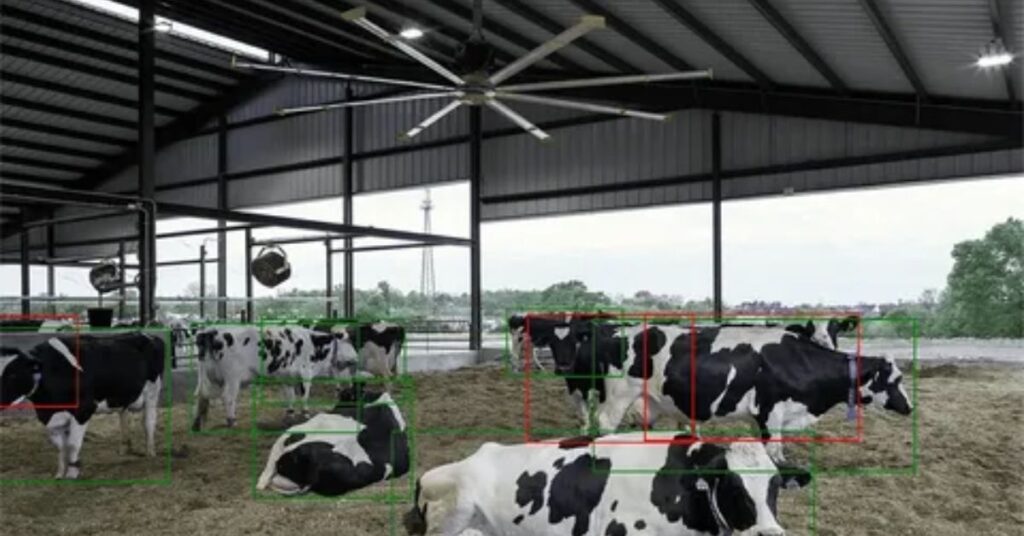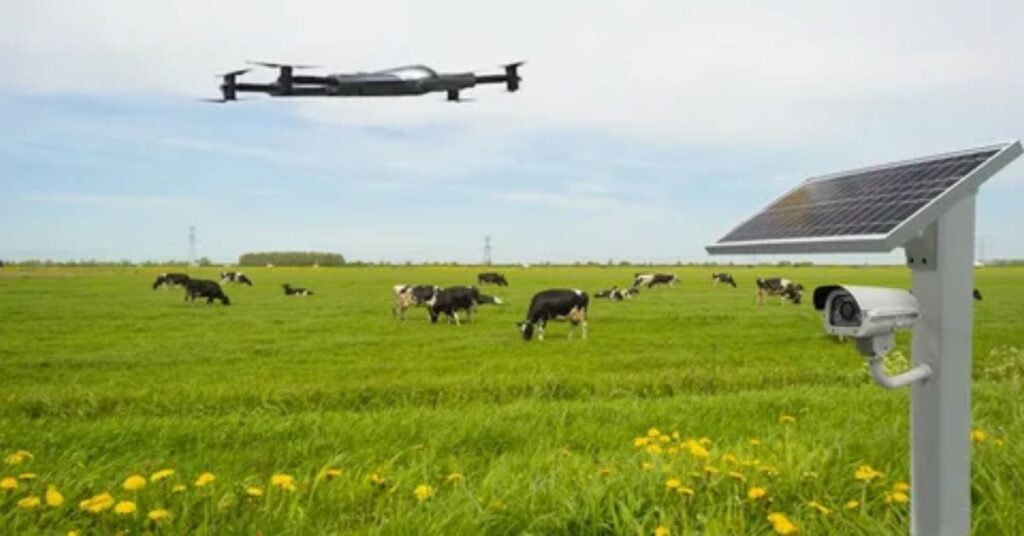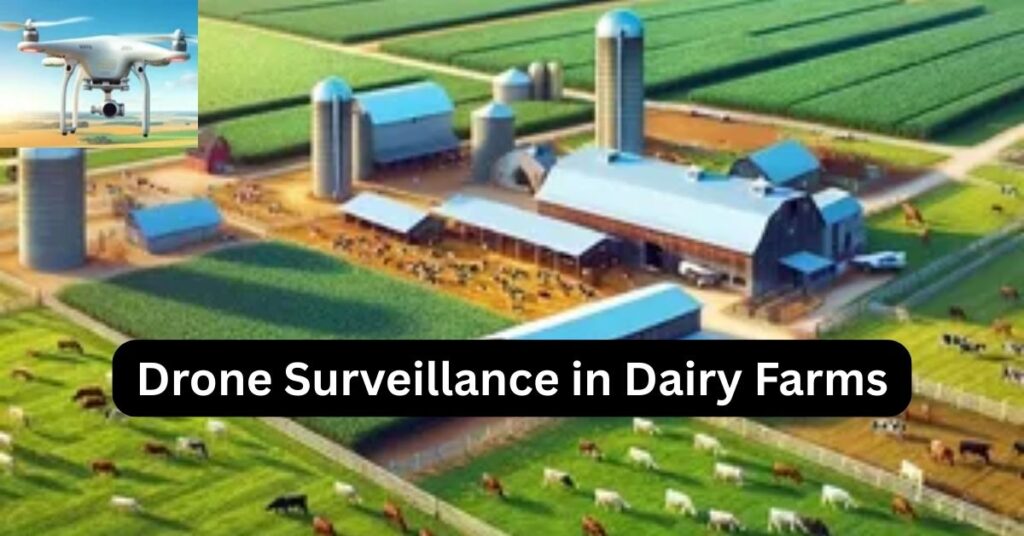A drone flying over a dairy farm monitoring cattle health and farm operations for better efficiency.
Picture this: it is early morning on a busy dairy farm. Instead of dozens of workers running around, a small drone buzzes through the sky, keeping an eye on every cow, water trough, and pasture section. This is the new era of Drone Surveillance in Dairy Farms, where agricultural drones act as farmers’ digital assistants. From cattle tracking technology to livestock health monitoring, drones are unlocking smarter, safer, and more efficient ways to manage dairy farms.
- What is Drone Surveillance in Dairy Farms?
- Why Dairy Farms Need Drone Surveillance
- Benefits of Drone Surveillance in Dairy Farms
- Challenges of Drone Surveillance in Dairy Farms
- Future Trends of Drone Surveillance in Dairy Farms
- Real-Life Examples of Drone Surveillance in Dairy Farms
- How Farmers Can Get Started with Drone Surveillance
- Conclusion
- FAQ's
What is Drone Surveillance in Dairy Farms?
Drone Surveillance in Dairy Farms means using farm surveillance drones equipped with advanced cameras, sensors, and AI software to monitor daily farm operations. These systems help farmers with:
- Drones provide farmers with a bird’s-eye view of barns, pastures, and cows in real-time. This allows faster inspections compared to manual field visits.
- AI-powered cameras track cow movement, grazing patterns, and grouping behavior. This ensures farmers quickly spot unusual activity or missing cattle.
- Thermal sensors detect early signs of fever, lameness, or injuries by capturing body temperature differences. Farmers can act before illnesses spread in the herd.
- Drone-generated maps highlight overused pastures, water shortages, or uneven feeding areas. This helps farmers adjust resources and reduce wastage.
This is the core of smart dairy farming, where drones replace manual guesswork with AI-powered technology delivering real-time insights.
Why Dairy Farms Need Drone Surveillance

Managing a large dairy farm is complex. Farmers need to balance:
- Livestock Health Monitoring (spotting diseases early)
Wearable sensors and smart devices help detect early symptoms of mastitis, lameness, or infections. Quick treatment reduces losses, lowers vet costs, and keeps cows healthier.
- Heat Stress Detection in Dairy Cows (A common problem in hot regions)
Smart collars and ear tags measure temperature and behavior to flag heat stress before it worsens. This ensures timely cooling actions, protecting milk yield in hot climates.
- Farm Safety (Preventing accidents and trespassing)
IoT-based cameras, virtual fencing, and alert systems enhance safety by monitoring farm perimeters. Farmers can prevent accidents, stop cattle escapes, and reduce theft risks.
- Dairy Farm Productivity (Maximizing milk yield)
Automation in feeding, milking, and monitoring ensures cows stay healthy and stress-free. Healthy cows give consistent, higher-quality milk, boosting farm profitability.
Traditional observation methods often fail because they are slow and labor-intensive. With drone technology in farming, these problems are solved through automated, efficient, and precise monitoring.
Benefits of Drone Surveillance in Dairy Farms

1. Advanced Livestock Health Monitoring
Drones equipped with thermal imaging for livestock can detect:
- Drones with thermal cameras can scan cows from above and spot unusual heat signals. This allows farmers to detect fever or infections early, reducing treatment costs and disease spread.
- By tracking movement from the sky, drones identify cows that limp or move less than normal. Early alerts help farmers address lameness or injuries before they affect milk yield.
- Drones observe how often and how long cows visit feeding areas. A sudden drop in eating time may signal illness, enabling quick veterinary action.
According to the USDA, early detection can save thousands of dollars in lost milk production each year.
2. Enhanced Dairy Farm Monitoring and Efficiency
Instead of sending workers on foot, farm surveillance drones scan the entire farm within minutes. This provides:
- Drones and smart sensors allow farmers to check large herds within minutes instead of hours. This speeds up daily routines while ensuring no cow is overlooked.
- Automation reduces the need for manual inspections, cutting workforce expenses. Farmers can reinvest these savings into herd health and farm upgrades.
- Drones capture thermal images, feeding activity, and grazing patterns in real time. This data helps farmers make quick, evidence-based decisions for better productivity.
3. Boosting Dairy Farm Productivity
Efficient cattle tracking technology helps monitor herd movement, grazing patterns, and resting times. All this contributes to:
- With smart monitoring and automation, farmers detect diseases early and respond quickly. This reduces stress and ensures cows live longer, healthier lives.
- Consistent feeding, stress-free environments, and real-time care lead to better productivity. Healthy cows naturally produce more milk with improved quality.
- Automation reduces waste, energy use, and unnecessary feed costs. This creates a balanced system where farms stay profitable while protecting the environment.
4. Improved Farm Safety and Security
Night-vision drones patrol dairy farms after dark, spotting unusual movements or potential intruders. They reduce the need for human night guards, lowering labor costs. Farmers also gain peace of mind knowing livestock and equipment are monitored 24/7. In addition, drones can scan dangerous zones first, keeping workers safe from accidents.
5. Supporting Smart Dairy Farming and Sustainability
Drones also support eco-friendly goals by:
- Drones equipped with IoT sensors monitor irrigation patterns and soil moisture. This prevents water waste and helps farmers adopt smarter, eco-friendly irrigation practices.
- Aerial drones scan grazing areas to detect overused patches of land. This supports pasture rotation planning, ensuring healthier grass growth and sustainable feeding.
- Drones map manure distribution across fields to avoid nutrient overload. This keeps farms compliant with environmental laws and reduces greenhouse gas emissions.
This brings smart dairy farming closer to sustainable agriculture practices worldwide.
Challenges of Drone Surveillance in Dairy Farms
Even with many advantages, Drone Surveillance in Dairy Farms faces several challenges:
- High Costs – Advanced AI-powered drones and analytics software can be expensive. For example, basic drones cost $1,000–$3,000, while thermal imaging drones range $5,000–$15,000, and fixed-wing models exceed $40,000. Farmers may also need software subscriptions ($500–$2,000 annually).
- Weather Issues – Unstable weather conditions limit the accuracy of drone-based monitoring in dairy farms. Strong winds or heavy rain can interrupt data collection, while extreme heat may shorten drone battery life.
- Data Privacy – Storing and analyzing sensitive farm data creates risks of breaches. Workers also raise concerns about being constantly monitored. Best practice is to set clear privacy policies.
- Regulations – Farmers must follow strict drone laws:
- USA (FAA): Registration + Part 107 rules, max altitude 400ft.
- EU (EASA): Pilot certification required.
- India: Drones >2kg need DGCA approval, though subsidies support farm drones.
- Pakistan: Emerging regulations, permission required.
- Netherlands: Strong adoption, but line-of-sight rules apply.
- USA (FAA): Registration + Part 107 rules, max altitude 400ft.
- Training Needs – Farmers must learn basic drone operation and data interpretation.
- Battery & Coverage Limits – Most drones fly 30–40 minutes per charge. Small drones cover ~50–80 acres, mid-range 200–300 acres, and fixed-wing drones up to 1,000 acres.
Future Trends of Drone Surveillance in Dairy Farms
- AI-Powered Precision Livestock Farming – Drones integrated with cow-wearable sensors will automatically send alerts like “Cow #22 shows signs of heat stress.”
- Swarm Drones – Groups of drones covering huge farms simultaneously, ideal for large-scale monitoring.
- IoT Integration – Linking drones directly to farm management software for dashboard-based insights.
- Sustainable Drone Models – Solar-powered drones to lower costs and carbon footprint.
- Global Expansion – Countries like India, Pakistan, and the Netherlands are rapidly scaling drone farming due to rising milk demand.
Real-Life Examples of Drone Surveillance in Dairy Farms
- USA (Wisconsin) – A 500-cow farm adopted thermal imaging drones covering up to 200 acres per flight. They reduced labor needs by two workers, saving $60,000 annually, and boosted milk yield by 15% through early mastitis detection.
- Pros of Using Drones in Dairy Farming
- Early Disease Detection – Drones equipped with thermal and visual cameras can spot changes in cow behavior or body temperature, helping farmers act before illnesses spread.
- Reduced Labor Costs – Routine tasks like herd monitoring and pasture inspection are automated, cutting down the need for manual labor and saving long-term expenses.
- Improved Farm Safety – Farmers can monitor cattle in remote or risky areas without entering dangerous terrain, reducing the chances of accidents or injuries.
- Efficient Farm Management – Aerial mapping helps track grazing patterns, pasture health, and water availability, ensuring smarter use of farm resources.
- Early Disease Detection – Drones equipped with thermal and visual cameras can spot changes in cow behavior or body temperature, helping farmers act before illnesses spread.
- Cons of Using Drones in Dairy Farming
- High Initial Investment – Professional-grade drones with advanced sensors can be costly, making them a big decision for small and mid-sized farmers.
- Limited Battery Life – Most drones operate for 20–40 minutes per charge, requiring frequent recharging or multiple devices for larger farms.
- Need for Staff Training – Farmers and workers must learn drone operation and data analysis, which takes time and sometimes outside support.
- Regulatory Restrictions – Drone use in agriculture is subject to airspace rules and permits, which can delay or limit how often drones are used.
- High Initial Investment – Professional-grade drones with advanced sensors can be costly, making them a big decision for small and mid-sized farmers.
- India – Farmers use drones to monitor heat stress during scorching summers, preventing production losses. Subsidies now make agricultural drones more affordable.
- Netherlands – Dairy farms use drones for pasture and manure management, integrating drone data with sustainability metrics.
These real-world examples show how drones are becoming essential tools for precision livestock farming worldwide.
How Farmers Can Get Started with Drone Surveillance
- Define your goal
Before investing in drones, farmers must set clear goals such as monitoring cow health, improving security, or boosting overall productivity. A defined purpose ensures the right features are chosen. This avoids unnecessary costs and maximizes return on investment.
- Choose the right drone
Different drones serve different purposes; basic models capture visual footage, while advanced ones use thermal imaging to detect heat stress or hidden illnesses. Farmers should select a drone that matches their farm’s unique needs. The right choice improves accuracy and efficiency.
- Train workers
Proper training ensures drones are handled safely around animals and staff. Workers must also learn how to interpret drone data, such as body temperature or movement patterns. This knowledge turns raw data into practical farm decisions.
- Start small
Instead of deploying drones across the entire farm, testing them on a smaller section helps identify challenges early. Farmers can then adjust strategies based on results. Once successful, the system can be scaled to the whole herd.
- Integrate software
Modern drones connect with farm management software to analyze health, feeding, and grazing data. This integration turns aerial images and metrics into actionable insights. Farmers can predict problems, cut losses, and improve overall herd productivity.
Conclusion
The rise of Drone Surveillance in Dairy Farms is reshaping modern agriculture. From livestock health monitoring to cattle tracking technology, drones help farmers boost productivity, cut costs, and improve sustainability.
Challenges like cost, training, and regulations exist, but with advancements in AI-powered drones, IoT integration, and swarm technology, the future of smart dairy farming looks brighter than ever.
Farmers who embrace drone technology today will be leading the dairy industry tomorrow.
FAQ’s
How do drones improve livestock health?
Drones improve livestock health by using thermal imaging and AI-powered cameras to detect early signs of disease, lameness, or heat stress in cattle, allowing farmers to act quickly.
Are agricultural drones expensive for small dairy farms?
Yes, but options exist. Basic drones start at $1,000, while advanced models can reach $20,000+. Subsidy programs in countries like India are making them more affordable.
What is the future of smart drone farming?
The future lies in combining IoT drones, AI analytics, and swarm technology to create precision livestock systems that are efficient, sustainable, and globally scalable.

